|
Printables |
PowerPoints |
Online exercises |
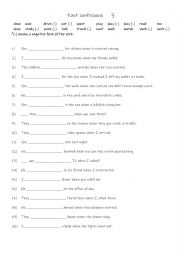
|
Past continuous 3
Learning the past continuous tense is important because it helps students describe actions that were in progress at a specific time in the past. It adds context and detail to storytelling, allowing for clearer descriptions of ongoing past events or interrupted actions. Mastering the past continuous improves fluency and accuracy in both speaking and...
Level: elementary
Age: 7-100
Type:
Downloads: 115
|
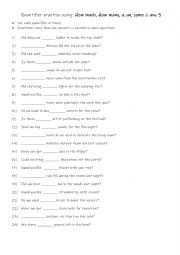
|
Quantifier practise using: How much, How many, a, an, some & any 3
Students first familiarise themselves with the 6 quantifiers and their use. Then they complete the gap-fill with the correct word. Each quantifier is used 4 times! Answers on page 2.
Level: elementary
Age: 8-100
Type:
Downloads: 115
|
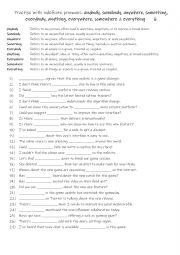
|
A2-B1 Practise with indefinite pronouns anybody, somebody, anywhere, something, everybody, anything, everywhere, somewhere & everything 6
Learning indefinite pronouns like anybody, somebody, anywhere, something, everybody, anything, everywhere, somewhere, and everything is essential for students to express general ideas or refer to non-specific people, places, or things. These pronouns are commonly used in everyday communication to ask questions (e.g., "Is there anybody here?"), make...
Level: elementary
Age: 9-100
Type:
Downloads: 114
|
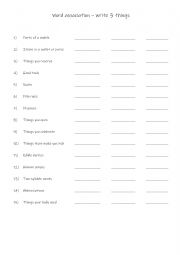
|
Word association � write 3 things
Word association � write 3 things
Level: intermediate
Age: 12-100
Type:
Downloads: 114
|
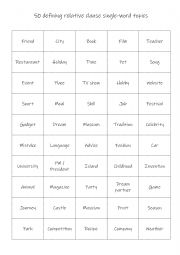
|
Defining relative clauses
50 defining relative clause single-word topics. Students pick a topic and define it.Topics include various: people, places , things and time etc. Or this worksheet can be used as a Tic-tac-toe / noughts and crosses speaking reinforcement activity for younger learners. It is suitable for B1+-C1 students.
Level: intermediate
Age: 12-100
Type: worksheet
Downloads: 114
|
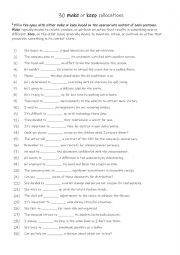
|
A2-B1 30 make or keep collocations
Students fill in the gaps with either make or keep based on the appropriate context of each sentence. Make typically means to create, produce, or perform an action that results in something new or different. Keep, on the other hand, generally means to maintain, retain, or continue an action that preserves something in its current state. Understandi...
Level: intermediate
Age: 10-100
Type: worksheet
Downloads: 114
|
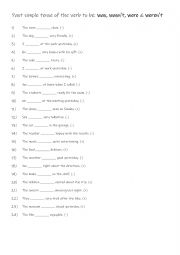
|
Past simple tense of the verb to be: was, was not, were & were not
This worksheet is suitable for A1+-A2 learners. Students read the sentence and complete the sentence with the correct form of the verb to be. They use the (+) or (-) sign at the end of the sentence to see if it needs a positive or negative form of the verb to be. Answers on page 2.
Level: elementary
Age: 8-100
Type: worksheet
Downloads: 114
|
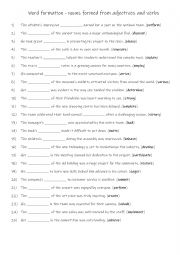
|
Word formation - nouns formed from adjectives and verbs
Vocabulary Expansion: Understanding how to form nouns from adjectives and verbs helps students build a richer vocabulary. For instance, learning that the adjective "happy" can turn into the noun "happiness," or the verb "create" can become the noun "creation," gives you more words to use and understand. Recognising patterns in word formation means ...
Level: intermediate
Age: 8-100
Type:
Downloads: 114
|
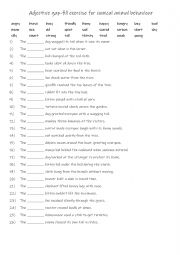
|
A1+-A2 Adjective gap-fill exercise for usual animal behaviour
After watching How funny animals behave on TV, I decided to make this worksheet to make it more interesting for students to associate some adjectives with animal traits. This worksheet is suitable for A1+-A2 students. Answers on page 2.
Level: elementary
Age: 8-100
Type:
Downloads: 114
|
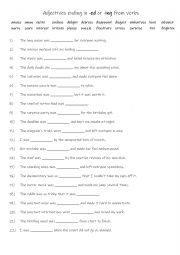
|
B1-B2 22 Adjectives ending in -ed or -ing from verbs practise
Learning these adjectives helps students describe emotions, feelings, and situations more accurately, allowing you to express yourself more vividly. Understanding the difference between -ed and -ing forms prevents common errors. For example, "bored" describes how you feel, while "boring" describes something that causes that feeling. Practicing thes...
Level: intermediate
Age: 10-100
Type:
Downloads: 114
|
|
|
|
|












